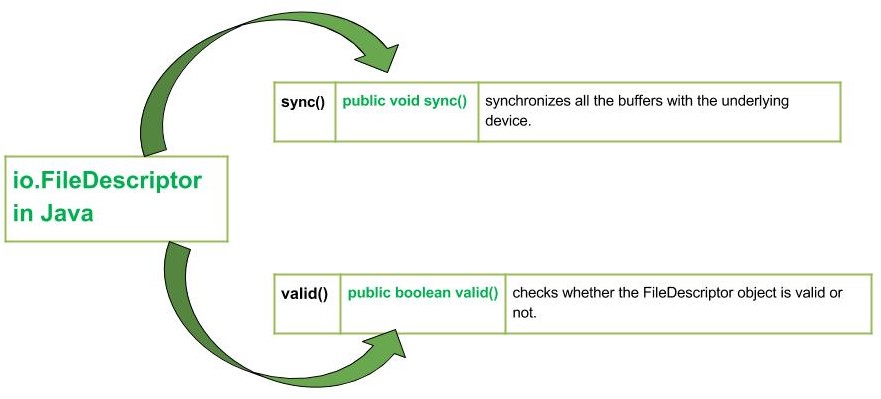java.io.FileDescriptor 用於打開具有特定名稱的文件。如果該文件中存在任何內容,它將首先刪除所有內容並將 “Beginning of Process” 作為第一行。文件說明符類的實例充當底層 machine-specific 結構的不透明句柄,表示打開的文件、打開的套接字或另一個字節源或接收器。
- 文件說明符的主要實際用途是創建 FileInputStream 或 FileOutputStream 來包含它。
- 應用程序不應創建自己的文件說明符。
領域
- err: 標準錯誤流的句柄。
- in:標準輸入流的句柄。
- out: 標準輸出流的句柄。
聲明:
public final class FileDescriptor extends Object
構造函數:
- FileDescriptor():構造一個FileDescriptor對象
方法:
- sync(): java.io.File.sync()將所有緩衝區與底層設備同步。當FileDescriptor的所有修改數據都已寫入底層設備時,該方法返回。
Syntax :
public void sync()
Parameters :
-----------
Return :
void
Exception :
-> SyncFailedException : This is exception is thrown if there is no guarantee of
synchronization of buffers with the device.
Java
// Java program explaining the working of sync() method
import java.io.*;
public class NewClass
{
public static void main(String[] args) throws IOException
{
// Initializing a FileDescriptor
FileDescriptor geek_descriptor = null;
FileOutputStream geek_out = null;
// HERE I'm writing "GEEKS" in my file
byte[] buffer = {71,69,69,75,83};
try{
geek_out = new FileOutputStream("FILE.txt");
// This getFD() method is called before closing the output stream
geek_descriptor = geek_out.getFD();
// writes byte to file output stream
geek_out.write(buffer);
// USe of sync() : to sync data to the source file
geek_descriptor.sync();
System.out.print("\nUse of Sync Successful ");
}
catch(Exception except)
{
// if in case IO error occurs
except.printStackTrace();
}
finally
{
// releases system resources
if(geek_out!=null)
geek_out.close();
}
}
}筆記:
您無法看到此代碼對代碼中提到的“FILE.txt” 文件所做的更改,因為 Online IDE 上不存在此類文件。因此,您需要將代碼複製到係統編譯器並觀察文件的更改
無論文件中存在什麽內容,它都會將您的文件同步到設備並覆蓋數據。現在文件“FILE.txt”的內容將是
GEEKS
即使不存在這樣的文件,它也會自行創建該文件,同步該文件,並寫入您提到的內容。
輸出:
Use of Sync Successful :)
- valid(): java.io.File.valid()檢查FileDescriptor對象是否有效。
Syntax :
public boolean valid() Parameters : ----------- Return : true : if the FileDescriptor object is valid else, false Exception : -----------
Java
// Java program explaining the working of valid() method
import java.io.*;
public class NewClass
{
public static void main(String[] args) throws IOException
{
// Initializing a FileDescriptor
FileDescriptor geek_descriptor = null;
FileInputStream geek_in = null;
try
{
geek_in = new FileInputStream("FILE.txt");
// get file descriptor
geek_descriptor = geek_in.getFD();
boolean check = false;
// Use of valid() : checking the validity of FileDescriptor
check = geek_descriptor.valid();
System.out.print("FileDescriptor is valid : "+check);
}
catch(Exception except)
{
// if in case IO error occurs
except.printStackTrace();
}
finally
{
// releases system resources
if(geek_in!=null)
geek_in.close();
}
}
}筆記:
您無法看到此代碼對代碼中提到的“FILE.txt” 文件所做的更改,因為 Online IDE 上不存在此類文件。因此,您需要將代碼複製到係統編譯器並觀察文件的更改。該方法將檢查 FileDescriptor 的有效性。
自從。代碼中的 FileDescriptor 有效,因此返回 true
輸出:
FileDescriptor is valid : true
概括:
- java.io.File.sync():將所有緩衝區與底層設備同步。
- java.io.File.valid()檢查FileDescriptor對象是否有效。
相關用法
- Java Java.io.File.canExecute()用法及代碼示例
- Java Java.io.File.canRead()用法及代碼示例
- Java Java.io.File.canWrite()用法及代碼示例
- Java Java.io.File.compareTo()用法及代碼示例
- Java Java.io.File.createNewFile()用法及代碼示例
- Java Java.io.File.createTempFile()用法及代碼示例
- Java Java.io.File.delete()用法及代碼示例
- Java Java.io.File.deleteOnExit()用法及代碼示例
- Java Java.io.File.equals()用法及代碼示例
- Java Java.io.File.exists()用法及代碼示例
- Java Java.io.File.getAbsoluteFile()用法及代碼示例
- Java Java.io.File.getAbsolutePath()用法及代碼示例
- Java Java.io.File.getCanonicalFile()用法及代碼示例
- Java Java.io.File.getCanonicalPath()用法及代碼示例
- Java Java.io.File.getFreeSpace()用法及代碼示例
- Java Java.io.File.getName()用法及代碼示例
- Java Java.io.File.getParent()用法及代碼示例
- Java Java.io.File.getParentFile()用法及代碼示例
- Java Java.io.File.getPath()用法及代碼示例
- Java Java.io.File.getTotalSpace()用法及代碼示例
- Java Java.io.File.getUsableSpace()用法及代碼示例
- Java Java.io.File.hashCode()用法及代碼示例
- Java Java.io.File.isAbsolute()用法及代碼示例
- Java Java.io.File.isDirectory()用法及代碼示例
- Java Java.io.File.isFile()用法及代碼示例
注:本文由純淨天空篩選整理自佚名大神的英文原創作品 Java.io.FileDescriptor in Java。非經特殊聲明,原始代碼版權歸原作者所有,本譯文未經允許或授權,請勿轉載或複製。

